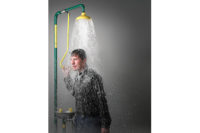
It’s just my bad luck to have a dad who is a safety geek,” my son exclaimed. “I don’t do ‘vert’ where kids fly up in the air and try to land back on the ramp. I do ‘ground boarding’ like when I make the board jump and flip then try to land on it.
“And I always wear my helmet.”
My son was right. He always wore his helmet skateboarding.
The issue between us had to do with elbow and knee pads.
“So son, I’ve seen you with the scrapes and bruises. You’ll be able to avoid those if you wear the pads. So why not?”
“They are uncomfortable and sweaty. And they make me less safe.”
“Less safe? Let me cite some safety statistics that blah, blah, blah…”
“But you’ve seen the tricks where I use my legs like arms to flip the board. Leg pads keep me from bending my knee well enough and get in my way. So I’m more likely to get hit by the board, fall and get hurt.”
Risk calculating
I knew he was right. The personal cost my son experienced to comply with my request to wear pads (from his perspective) was: a) discomfort; b) inhibited performance; c) inconvenience; and d) looking silly (with the bulging knees and elbows). In contrast, dad’s approval was the sole benefit of compliance. The cost/benefit ratio shows a greater cost for safety. When costs outweigh benefits, safety-related behavior does not happen.Principle 1: Safety-related behavior is often less convenient, less comfortable, and provides less dexterity than the more risky alternative.
But what could possibly be more important than dad’s approval? After an investigation of his skateboard world I found out. Skateboarding magazines contain the ultra-cool boarding professionals photographed in impossible aerial poses, all with rock-star hair, the hottest gear, and… no pads (and rarely helmets).
Surely, this wasn’t influencing my son. But when I took him to the county’s new skate park, I saw other kids had the tricks, the styles, even the laughter of the pros… all with the absence of pads and helmets.
Principle 2: We are influenced by others, especially if they are considered “cool.”
So I did what any dad would do. I declared a “threat.” “You WILL wear your pads when skateboarding or you will…. never… skateboard… again (echo here).” And he complied, or so I thought. The next week I drove up the driveway to see my son taking his pads off after boarding. It was an illusion squashed when his younger brother tattled that he had just spent the afternoon boarding without pads. When he saw my car he ran to his pads and shoved them on.
Principle 3: Threats and discipline are only effective when the disciplinarian is present.
My threats did not work so I upped the ante. I proceeded to contact the county parks director and county commissioners announcing myself as a safety professional and detailing what I had seen at the skate park — how unsafe behaviors were being modeled, and how there were no policies or signs requiring helmet and pad use in the skate park. I was not the only one protesting.
Soon the county commissioners passed a law: all patrons of the skate park must wear helmets and pads. Up went the verbose sign with the new statute. Nothing changed.
Principle 4: Policies and signs only direct behavior, they do not motivate safe behavior.
They cannot without consequences (see Principle 3 to review what happens to consequence without oversight). Is the only solution to have a consequence provider watching at all times?
That’s what happened. The county hired a security guard to enforce the new safety policy.
Letter to the editor
My son then wrote this letter to the editor of our local paper:Some people are misguided on the issue of protective gear. I have nothing against helmets because I’ve banged my head a few times with it on and it still hurts and I know people who have been seriously injured because they were not wearing one. Though I have nothing against helmets, I disagree with skateboarding pads because they affect your looks and most importantly performance. Mainly skateboarding pads are used for a style of skating called vert, half pipe mini pipe and ramps, but it has been proven that pads can decrease your performance and lead to further injury in other more technical non-ramp styles of skateboarding most of the skaters at the skate park perform. Myself and the majority of skateboarders I know are refusing to come to the skate park because of these requirements.
Yet our town is spending $40,000 for a security guard to enforce the rules. We would be better to use that money to expand the park to allow skaters to be more spread out, decreasing the chance of injury. I believe this action by the county was not economic but rather a decision based on the stereotype that skaters are a bunch of hooligans and require a security guard. I know the skate park will lose the majority of its frequent skaters who will look to the streets once again as their place to skate, defeating the original purpose of the gift of the local skate park.
He was right: The park closed from lack of attendance that same year. I was right: He fell to the ground boarding, hurt his elbow and kept him on the DL during his baseball season. I took the issue to higher authorities; he resisted even more. We should have worked together. We were both wrong.
